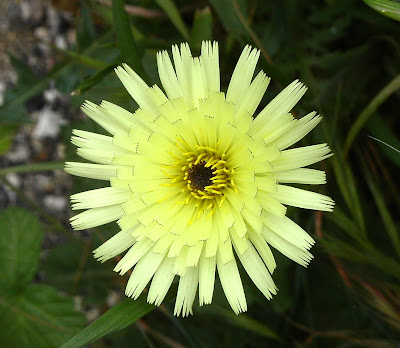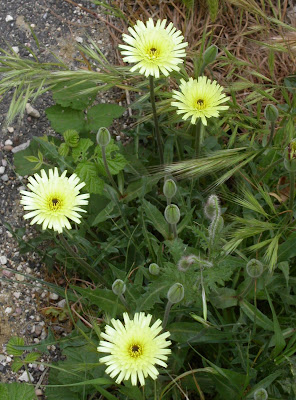After a major ice storm and rain, the garden is stripped bare of all except hardscape, battered grasses, and mud. Yesterday a heavy fog, brought by a warm front that ended the snow cover, gave the opportunity to measure this year's progress toward creating a sense of mystery, a journey, a narrative - mostly independent of the plantings so prominent in other seasons. The photos in this post were taken yesterday, and you'll see snow and fog in them, and this morning, where you see no snow and no fog. To see detail, you'll need to click on the photos to enlarge them.
Entering through the Woodland Path
To get a sense of narrative, of some as yet untold story, it's best to enter the garden by way of the woodland path. This starts at a gate on the right end of the house and circles around through the woodland garden to the main garden at back. This is a wood chip path shown in the two photos above, and below, where you can see the path meeting a long curving stone wall that carries the view deep into the garden.
The stone walls added this year, and a long, narrow, canal like pond have created structure that controls the movement of both the eye and the body, giving the woodland entrance to the garden a firm direction and flow. Curves do it all... the curving path and wall through the woods, around the end of the house, into the large garden at back (below)...
the curves of two stone walls that enclose the view on the left and right...
the curve of the pond (below) directing the eye along the natural drainage flow across the garden and into the woods beyond...
and the curve of the wall lining the long path (below) as it begins its circle of travel around the entire garden...
These views show me I need evergreens to achieve better screening both in summer and especially in winter. I've been reluctant to try anything evergreen in my wet clay (I don't want to spend scarce money on expensive shrubs likely to die, or worse, live long, lingering, ugly deaths). But looking at these photos, I'm convinced it's time to take the risk.
A Second Entrance: Steps
During the the short transit through the woodland garden, a second entrance, from the terrace behind the house, reveals itself (okay, it's only a start).
Built of local stone, these low steps will give access directly from the back of the house onto a soft wood chip path, circling immediately around the stone wall directly to the pond, then continuing out into the middle of the garden.
The rather barren area at the foot of the steps has been planted with a variety of groundcover plugs (tiarella, phlox stolonifera), bunches of Ostrich fern (Matteuccia struthiopteris), and legacy daffodils, but it needs winter color. I'm considering willows (maybe Salix alba 'Britzensis') and some form of red twig dogwood, in bunches. You get the idea.
Continuing into the garden (below), glancing to the right, you see the space opening up, looking back over to the pond and the wall at the base of the house ...
... and further right, a small bridged drainage channel to carry off excess water and provide habitat for more bog plants ...
... such as the three Salix alba 'Britzensis' below. I've rooted cuttings of these and should have a virtual wall of them here next year.
And at the end of the wall, the dried remains of a flower of Ligularia japonica (from Plant Delights, where else?).
And at the very end of the path, a view of the slope going up to the house, blousy with miscanthus.
This "story" may never be told, not in a finished way. I'm just trying to ask the right questions, to set the stage.















